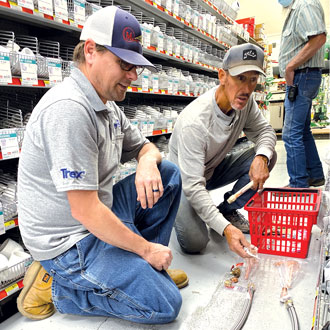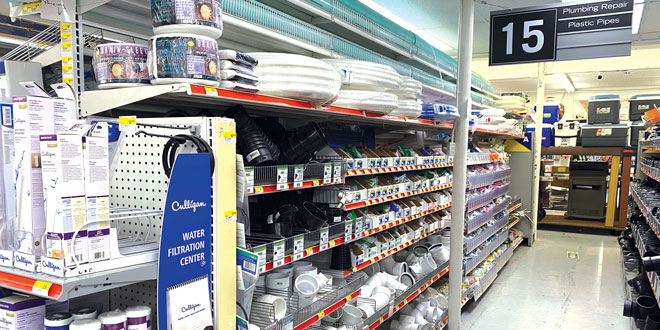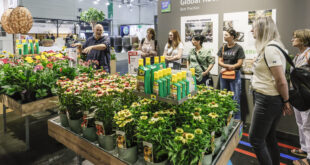Whether it takes up one aisle or a large portion of your store’s square footage, the plumbing department is a key category for many home improvement retailers.
Finding success in this category requires the right combination of product assortment, employee knowledge and an ability to help with everything from emergency repairs to planned remodels.
Miller’s Do it Best Home Center in Baker City, Oregon, has found success in the plumbing category thanks to its large selection of products, but the store’s plumbing department shines because of its commitment to assist customers, especially DIYers, in emergency situations. Leading the charge is store manager Daryl DeMoss, a former journeyman pipefitter who also has his master plumber license.
 Putting Customers First
Putting Customers First
DeMoss has a propensity for thinking of others’ needs first, which comes through in his role at Miller’s too, where he uses his professional plumbing experience to assist customers, especially DIYers who need a little extra guidance. Every day, DeMoss assists customers with diagnosing plumbing problems, finding the right parts and choosing products for a remodel. It’s not rare for DeMoss to take his skills outside the store too; he recently went to an elderly customer’s home to repair a leaking hose bibb that was causing flooding in the basement.
Because of his plumbing experience, DeMoss has developed good relationships with local plumbers who can recommend to customers. But if those plumbers are too busy to help a customer and that customer has a water leak or repair they need taken care of right away, DeMoss will go and fix it himself at no charge to the customer.
“In my opinion, there’s more to business than making money,” DeMoss says. “There are relationships that are built.”
That commitment to customer service trickles down to the other employees through DeMoss’s leadership. Employee training is an ongoing process, and DeMoss teaches by doing.
“Anytime an employee brings a customer to me with a plumbing question or issue, I have that employee stay with me. Together, we walk the customer all the way through the process so my employee learns to ask the right questions and see different ways they can help,” DeMoss says.
Through this hands-on training, employees learn how to assist all customers, who are split evenly between professionals and DIY shoppers.
The customer service doesn’t end in the store, however; customers can visit the store’s Facebook page for plumbing how-to posts. Past posts have included tips on using specialty fittings and how to tile a tub or shower surround.
Plenty of Product
Along with having experienced and knowledgeable employees, Miller’s Home Center also boasts a robust plumbing selection. The plumbing department occupies 2,000 square feet of the 18,000-square-foot salesfloor. There’s also a section of outdoor space for larger items like septic tanks and large pieces of pipe.
The interior plumbing section includes a complete wall of pipe and four aisles of plumbing products, plus several other wall displays. Customers can also browse the store’s selection of faucets, shower valves, toilets, showers and tubs.
During his tenure at Miller’s, DeMoss has grown the plumbing department, filling in product voids as he sees them. He sources products from the store’s wholesaler and through other vendors, and he also keeps a selection of products in stock for a core base of plumbing contractors who frequently use Miller’s.
DeMoss makes the most of the store’s limited space by setting up several how-to displays that allow customers to see firsthand how to tackle and finish a plumbing project.
“We have some displays with different types of fittings that show customers how those particular fittings work. We also frequently open packages so customers can see how parts fit together,” DeMoss says. “We have more hands-on displays in the store than fancy merchandising.”
DeMoss is confident that even if the store doesn’t have a particular item a customer needs, they will return when another home improvement need comes up because of the store’s focus on results-oriented customer service.
“Sometimes we might not make a sale because we don’t have what a customer needs,” DeMoss says. “But it’s all about making a connection and getting that conversation going to get them coming back the next time.”
When the store doesn’t carry a specific plumbing product a customer needs, employees can special order many items. Miller’s relies on its co-op’s retail solution center to fulfill special orders; the local warehouse stocks many items that Miller’s can’t. His supplier also arranges for drop-shipping from popular plumbing vendors and ships from the co-op’s other warehouses if the local warehouse doesn’t have an item.
“Our staff is good about searching the internet and finding and buying what our customers need,” DeMoss says. “We are never going to abandon a customer, and we are always willing to recommend a specialty store, or even our competition, to get their problem solved.”
What’s Trending in Plumbing
While the meat of a plumbing category centers on what goes in walls and under cabinets, the stars of the category are the pieces people see every day. Here’s a look at what is trending in plumbing products in 2021.
![]() Finishes. Brushed nickel has emerged as a front-runner in fixture finishes, ahead of oil-rubbed bronze. The National Kitchen and Bath Association’s (NKBA) 2021 Design Trends report found black matte is another popular option.
Finishes. Brushed nickel has emerged as a front-runner in fixture finishes, ahead of oil-rubbed bronze. The National Kitchen and Bath Association’s (NKBA) 2021 Design Trends report found black matte is another popular option.
![]() Smart Tech. Water conservation monitors and temperature controls for faucets are hot products in bathrooms and kitchens. Smart toilets and bidets that flush automatically and have heated seats are also gaining popularity.
Smart Tech. Water conservation monitors and temperature controls for faucets are hot products in bathrooms and kitchens. Smart toilets and bidets that flush automatically and have heated seats are also gaining popularity.
![]() Sinks. Pedestal sinks are nearly obsolete; the 2021 NKBA Design Trends report found only 3 percent of homeowners want a pedestal sink in the bathroom. The most popular sink finishes are stainless steel and white porcelain.
Sinks. Pedestal sinks are nearly obsolete; the 2021 NKBA Design Trends report found only 3 percent of homeowners want a pedestal sink in the bathroom. The most popular sink finishes are stainless steel and white porcelain.
![]() Tubs. Homeowners are opting for standalone rather than built-in tubs to save space and make a statement. The most popular tub color is still white, but bold colors like yellow and teal are making their way into bathrooms.
Tubs. Homeowners are opting for standalone rather than built-in tubs to save space and make a statement. The most popular tub color is still white, but bold colors like yellow and teal are making their way into bathrooms.
 Hardware Retailing The Industry's Source for Insights and Information
Hardware Retailing The Industry's Source for Insights and Information








